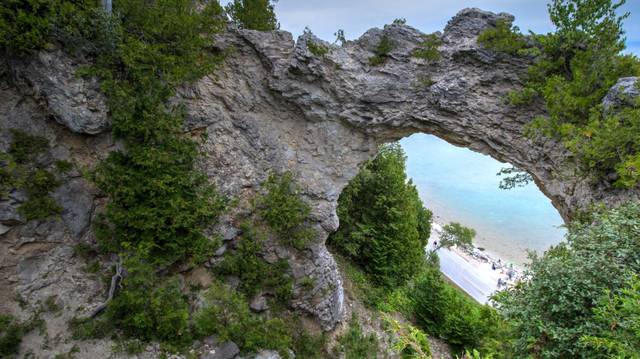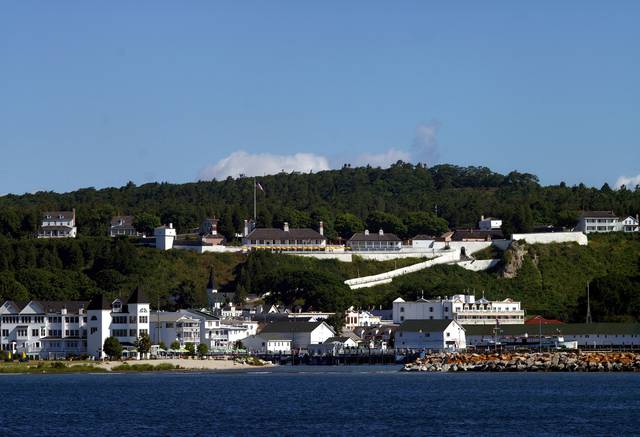
Mackinac Island is a resort island famous for its colonial to victorian era character, situated in the Straits of Mackinac, connecting Lake Michigan and Lake Huron. The name is pronounced "MAK-in-aw". First inhabitated by the Ojibwe tribe and then settled by Europeans in the mid 1600s, the village of Mackinac was finally incorporated in 1817 and served as the seat for the territorial county of Michilimackinac by 1818 and as the seat of Mackinac County from 1849-1882. The territorial county of Michilimackinac covered much of what is now Michigan. Fort Mackinac housed the central government for the Northern Frontier after the American Revolution. By the end of the War of 1812, the Island figured prominently in the governing and early development of the Northwest Territory. Mackinac Island is really three different travel destinations: Grand Mackinac, the posh and expensive resort exemplified by the Grand Hotel; Fudgie Mackinac, the popular historical and shopping experience of the throngs arriving by ferry; and Active Mackinac, the bicycling, horse-riding, paddling, and hiking opportunity. These aren't 100% exclusive of each other, but your experience of the island will vary substantially depending on which you are there for.

All three of Mackinac Island's foremost sights were built during the late 1800s or are interpreted as if one was visiting them in that period. These sights form key elements in the total-immersion nature of Victorian culture and iconography on Mackinac Island. The central "village" consists of only two streets, Main Street and Market Street. Most of both streets are lined with shops that depend on the seasonal tourist trade. Main Street has good examples of vernacular false-front commercial architecture of the late 1800s. Many Market Street buildings are even earlier, built during the fur-trade boom of the War of 1812 period. The village is tightly-clustered on the southern end of the island. On a steep bluff above Main Street is Fort Mackinac. Although the stone walls of the fort were raised by the British Army in 1780-81 in a failed attempt to keep the American "rebels" from gaining control of Michigan, most of the frame buildings inside the fort were built in the 1800s. The Mackinac Island State Park currently (2005) interprets the fort to its life in the 1880s. An admission fee is charged. There are excellent views of the village, Mackinac Bridge, and nearby shipping channel from the fort's walls. Halfway up another steep hill to the north-west is the Grand Hotel, a substantial 1884 summer "palace" offering upscale accommodation. Visitors often find the hotel, with its record-length front porch, to be an attractive place to appreciate a relatively complete pre-World War I environment. The 1980 Christopher Reeve movie Somewhere in Time is set and was filmed here. An admission fee is charged to non-guests. The stores, fort, and hotel are open in the late spring, summer, and fall, and closed in the winter and early spring. Most of Mackinac Island's visitors come to the Island between the Lilac Festival (early June) and Labor Day. During the long cold winters, permanent residents are sometimes forced to follow a path made of discarded Christmas trees over the ice to nearby St. Ignace for supplies.

Mackinac Island's ban on motor vehicles has created a unique style of participatory recreation, accessible to year-round residents and visitors alike. A wide variety of footpaths and saddle-horse trails snake through the interior of Mackinac Island. Several of these trails have been in use for at least 150 years. Most Islanders get from place to place by bicycle or horse-drawn carriage, and welcome visitors who do the same thing. Thousands of tourists bring their own bikes to Mackinac Island each year. All three ferryboat lines welcome bikes, although they charge a supplemental fare for them. M-185, known locally as Main Street, is the 8-mile, relatively flat paved trail around the Island and a favorite destination. Bicycles can also be rented by the hour, and prices start about $5 an hour for a single speed bike with a basket. The largest horse and buggy livery in the world is Mackinac Island Carriage Tours who provides a horse-drawn ride along a set route through the interior of the Island. The Grand Hotel provides guests with horse-drawn carriage service from the ferry docks to the hotel via their horse-drawn omnibus for a fee. Regular horse-drawn taxis are available 24/7 to take visitors to hotels, restaurants and homes for a fee. The Island is broken into several zones and taxi fare starts around $5 per person each way. Taxis will not wait so its important to be ready for pick up. Visitors can also rent saddle horses or Drive Your Own Buggies by the hour via Cindy's Riding Stable and Jack's Livery Stable. Private tours with a driver are also available from Gough's Livery and Mackinac Island Carriage Tours. Mackinac Island Carriage Tour Company offers great tour packages an excellent way to see the island hitting the major things to see including Fort Mackinac, Wings of Mackinac, Arch Rock and also offers a last stop at the Grand Hotel. For an interesting view of the islands history, ghost stories, and legends, take a easy paced walking tour with Haunts of Mackinac and their Haunted History Tours. Haunts of Mackinac Tours are an entertaining and informative way to spend your evening on Mackinac Island.
- Three 9-hole golf courses have been carved out of the interior of the island. On Grand Hotel property is the Grand Nine and up Island is the second nine hole course called the Woods. Horse drawn carriages move golfers between the two courses and there are golf carts available while on each course. Wawashkamo is a Scottish Links course and one of the oldest golf courses in the country. Created in the late 1800s, this is the closest to Scotland any one could hope for.
- Mackinaw Breeze. The is a charter sailboat that docks during summer months and is docked at the Bay View Bed & Breakfast. The Breeze offers 1 1/2 and private cruises from the island's harbor in the Straits of Mackinac.
During the 1800s, Mackinac Island was a center of the Great Lakes fishing trade, with shoals of lake trout and whitefish pulled out of the Straits of Mackinac and re-shipped to urban markets. Although the island's Arnold Line Dock and adjacent Coal Dock were built in part to serve fish shippers and remain in active use to this day, commercial fishing has ceased on Mackinac Island. Since the 1880s, Mackinac candymakers have made and sold fudge to visitors. These days, there are five fudge companies on the island: Joann's, May's, Murdick's, the Murray Hotel, and Ryba's. Much, but not quite all, of the fudge sold on Mackinac Island is made with traditional ingredients and in fealty to the traditional labor-intensive process for making this confectionwhich involves oxidizing, or paddling the fudge on a slab of marble. During the process, the cooked fudge slowly cools and hardens into a loaf-shaped, semi-circular log.
- Carriage House. This restaurant offers an excellent opportunity for al-fresco dining.

Mackinac Island has more than 30 licensed locations where alcohol is sold. While alcohol has been consumed here in large quantities since the fur-trading era, many current licenses are held by restaurants and bars operating inside the summer hotels. A few drinking places of special interest are:
- Horn's Gaslight Bar, 7300 Main Street. A 19th century saloon atmosphere with Southwest and traditional American fare. The first bar in Michigan to gain a liquor license after prohibition, Horn's is a favorite spot for entertainment, dancing and all around fun.
- The Pink Pony, 7221-105 Main Street. An old-fashioned street-level bar within the Chippewa Waterfront Hotel, it is a traditional gathering place for yachters who have successfully finished either of the Great Lakes's two long-distance sailboat races, the Chicago-to-Mackinac or the Port-Huron-to-Mackinac.
Because of its unique horse-and-bicycle culture, the island is a relatively safe place for families to walk on the sidewalks and bike on streets and roads. Living in a horse town is not familiar to most folks in the 21st century, please know...the horses always have the right of way. The island's unusual brecciated geology has produced a series of hills and bluffs that are beautiful and great to photograph. Maps are available and getting around on a private buggy or bicycle proves most convenient. The climate on Mackinac Island has been considered a healing place for centuries and quite comfortable as the winds keep moving in all directions, blowing out the allergens and insects.
Because of its position, Mackinac is a popular stop for those traveling from the Upper Peninsula to destinations in the Lower Peninsula, and vice versa. Dmoz:Regional/North_America/United_States/Michigan/Localities/M/Mackinac_Island/
